Difference between revisions of "Viss Rug"
| Line 24: | Line 24: | ||
|Common designs = [[Geometric Design|Geometric]], [[Herati Design|Herati]] (Fish) | |Common designs = [[Geometric Design|Geometric]], [[Herati Design|Herati]] (Fish) | ||
|Common motifs & patterns = | |Common motifs & patterns = | ||
| − | |Common sizes = Red, Beige, Blue, Navy Blue | + | |Common sizes = |
| − | + | |Common colors = Red, Beige, Blue, Navy Blue | |
|Dyeing method = [[Natural Dyeing|Natural]], [[Synthetic Dyeing|Synthetic]] | |Dyeing method = [[Natural Dyeing|Natural]], [[Synthetic Dyeing|Synthetic]] | ||
|Pile material = [[Wool]] | |Pile material = [[Wool]] | ||
Revision as of 12:25, 14 September 2019
| Viss Rug | |
|---|---|
 Design of Viss Rug (Rugman) | |
| General information | |
| Name | Viss Rug |
| Original name | قالي ویست |
| Alternative name(s) | Viss Carpet |
| Origin | |
| Category | Village |
| Technical information | |
| Common designs | Geometric, Herati (Fish) |
| Common colors | Red, Beige, Blue, Navy Blue |
| Dyeing method | Natural, Synthetic |
| Pile material | Wool |
| Foundation material | Cotton |
| Knot type | Symmetrical (Turkish) |
Wiss rugs originate from Wiss, also referred to as Viss, a small town located near Hamadan. However, for a small town, Wiss has an eclectic mix of population. Kurds, Turks, and the nomadic people of Bakhtiari all call Wiss home, and it is the influence from these diverse groups that is an integral part of the weaving of wool rugs here. Due to its largely nomadic population, the majority of Wiss rugs feature geometric designs, which is an indication of a tribal rug. Its location so close to Hamadan has influenced the local weavers to create their wool rugs using the Hamadan weave, also referred to as the Sennah Baft. These wool rugs are woven with a Turkish symmetrical knot and a single shot of weft between the rows of knots.[citation needed]